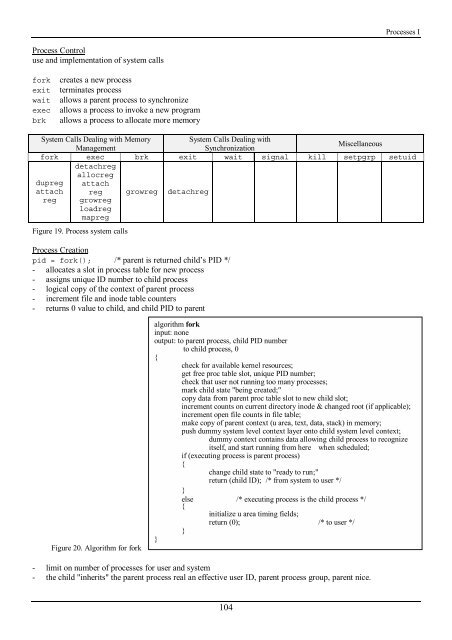Create successful ePaper yourself
Turn your PDF publications into a flip-book with our unique Google optimized e-Paper software.
Processes I<br />
Process Control<br />
use and implementation of system calls<br />
fork<br />
exit<br />
wait<br />
exec<br />
brk<br />
creates a new process<br />
terminates process<br />
allows a parent process to synchronize<br />
allows a process to invoke a new program<br />
allows a process to allocate more memory<br />
System Calls Dealing <strong>with</strong> Memory<br />
System Calls Dealing <strong>with</strong><br />
Management<br />
Synchronization<br />
Miscellaneous<br />
fork exec brk exit wait signal kill setpgrp setuid<br />
dupreg<br />
attach<br />
reg<br />
detachreg<br />
allocreg<br />
attach<br />
reg<br />
growreg<br />
loadreg<br />
mapreg<br />
growreg detachreg<br />
Figure 19. Process system calls<br />
Process Creation<br />
pid = fork(); /* parent is returned child’s PID */<br />
- allocates a slot in process table for new process<br />
- assigns unique ID number to child process<br />
- logical copy of <strong>the</strong> context of parent process<br />
- increment file and inode table counters<br />
- returns 0 value to child, and child PID to parent<br />
Figure 20. Algorithm for fork<br />
algorithm fork<br />
input: none<br />
output: to parent process, child PID number<br />
to child process, 0<br />
{<br />
check for available kernel resources;<br />
get free proc table slot, unique PID number;<br />
check that user not running too many processes;<br />
mark child state "being created;"<br />
copy data from parent proc table slot to new child slot;<br />
increment counts on current directory inode & changed root (if applicable);<br />
increment open file counts in file table;<br />
make copy of parent context (u area, text, data, stack) in memory;<br />
push dummy system level context layer onto child system level context;<br />
dummy context contains data allowing child process to recognize<br />
itself, and start running from here when scheduled;<br />
if (executing process is parent process)<br />
{<br />
change child state to "ready to run;"<br />
return (child ID); /* from system to user */<br />
}<br />
else /* executing process is <strong>the</strong> child process */<br />
{<br />
initialize u area timing fields;<br />
return (0); /* to user */<br />
}<br />
}<br />
- limit on number of processes for user and system<br />
- <strong>the</strong> child "inherits" <strong>the</strong> parent process real an effective user ID, parent process group, parent nice.<br />
104
















